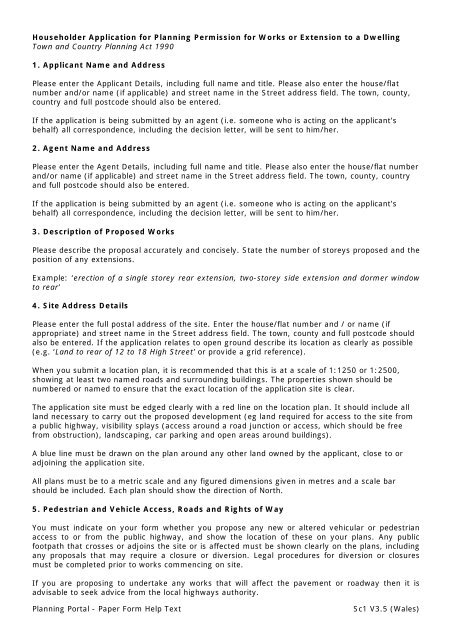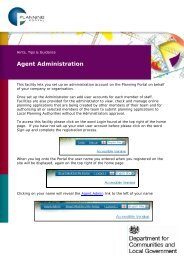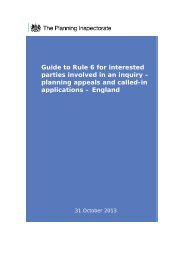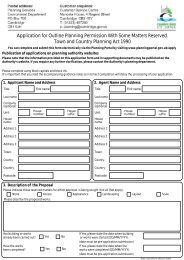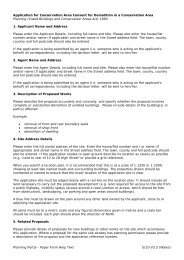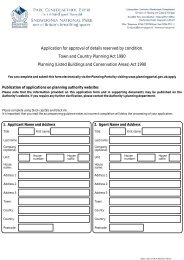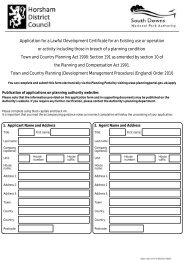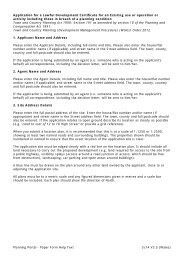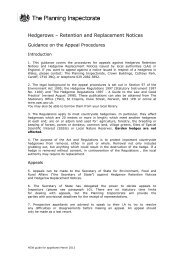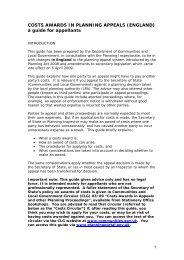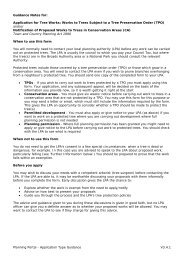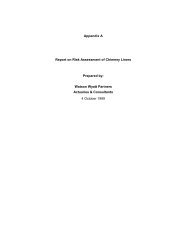Householder Application for Planning Permission ... - Planning Portal
Householder Application for Planning Permission ... - Planning Portal
Householder Application for Planning Permission ... - Planning Portal
Create successful ePaper yourself
Turn your PDF publications into a flip-book with our unique Google optimized e-Paper software.
<strong>Householder</strong> <strong>Application</strong> <strong>for</strong> <strong>Planning</strong> <strong>Permission</strong> <strong>for</strong> Works or Extension to a DwellingTown and Country <strong>Planning</strong> Act 19901. Applicant Name and AddressPlease enter the Applicant Details, including full name and title. Please also enter the house/flatnumber and/or name (if applicable) and street name in the Street address field. The town, county,country and full postcode should also be entered.If the application is being submitted by an agent (i.e. someone who is acting on the applicant'sbehalf) all correspondence, including the decision letter, will be sent to him/her.2. Agent Name and AddressPlease enter the Agent Details, including full name and title. Please also enter the house/flat numberand/or name (if applicable) and street name in the Street address field. The town, county, countryand full postcode should also be entered.If the application is being submitted by an agent (i.e. someone who is acting on the applicant'sbehalf) all correspondence, including the decision letter, will be sent to him/her.3. Description of Proposed WorksPlease describe the proposal accurately and concisely. State the number of storeys proposed and theposition of any extensions.Example: ‘erection of a single storey rear extension, two-storey side extension and dormer windowto rear’4. Site Address DetailsPlease enter the full postal address of the site. Enter the house/flat number and / or name (ifappropriate) and street name in the Street address field. The town, county and full postcode shouldalso be entered. If the application relates to open ground describe its location as clearly as possible(e.g. ‘Land to rear of 12 to 18 High Street’ or provide a grid reference).When you submit a location plan, it is recommended that this is at a scale of 1:1250 or 1:2500,showing at least two named roads and surrounding buildings. The properties shown should benumbered or named to ensure that the exact location of the application site is clear.The application site must be edged clearly with a red line on the location plan. It should include allland necessary to carry out the proposed development (eg land required <strong>for</strong> access to the site froma public highway, visibility splays (access around a road junction or access, which should be freefrom obstruction), landscaping, car parking and open areas around buildings).A blue line must be drawn on the plan around any other land owned by the applicant, close to oradjoining the application site.All plans must be to a metric scale and any figured dimensions given in metres and a scale barshould be included. Each plan should show the direction of North.5. Pedestrian and Vehicle Access, Roads and Rights of WayYou must indicate on your <strong>for</strong>m whether you propose any new or altered vehicular or pedestrianaccess to or from the public highway, and show the location of these on your plans. Any publicfootpath that crosses or adjoins the site or is affected must be shown clearly on the plans, includingany proposals that may require a closure or diversion. Legal procedures <strong>for</strong> diversion or closuresmust be completed prior to works commencing on site.If you are proposing to undertake any works that will affect the pavement or roadway then it isadvisable to seek advice from the local highways authority.<strong>Planning</strong> <strong>Portal</strong> - Paper Form Help TextSc1 V3.5 (Wales)
6. Pre-application AdviceThe local authority may be able to offer (possibly <strong>for</strong> a fee) pre-application discussions be<strong>for</strong>e a<strong>for</strong>mal application is submitted in order to guide applicants through the process. This can minimisedelays later in processing the application.Pre-application discussions can also help you and the planning authority identify areas of concernabout your proposed development so that you can give consideration to amending your proposalbe<strong>for</strong>e the application is submitted. The advice and guidance given to you at the pre-applicationstage is given in good faith. However, it does not guarantee or supply a definitive undertaking as towhether your proposal is likely to be acceptable.If you have received pre-application advice from the planning service please indicate thereference/date of any correspondence or discussion and the name of the officer. If you do not knowthese details then please state ‘Unknown’.This will assist the Council in dealing with your application as quickly as possible.7. Trees and HedgesPlease mark on a scaled plan the position of all trees and hedges on your own property and those onadjoining land which are within falling distance of the boundary (i.e. the distance from the boundaryto the trees and hedges is less than (or equal to) their height).This in<strong>for</strong>mation will help us consider how your proposal might affect these trees and hedges. If youknow what species the trees are, please name them. Number the ones that you will need to removeor prune in order to carry out your proposal.[PLEASE NOTE this is an application <strong>for</strong> planning permission. It is not an application or notification toremove or prune protected trees (i.e. trees which are included in a tree preservation order orlocated in a conservation area).If you are granted full planning permission, you will not need to obtain separate consent <strong>for</strong> treeworks which are required to implement the planning permission. However, works to protected treeswhich are not required to implement the planning permission must be the subject of a separateapplication or notification using the tree works <strong>for</strong>m.]<strong>Planning</strong> <strong>Portal</strong> - Paper Form Help TextSc1 V3.5 (Wales)
8. ParkingPlease specify the total number of existing parking spaces and the total number of proposed parkingspaces (including spaces retained) by vehicle type. Please include garage spaces.If no parking spaces are to be provided you should show on your plans or describe in a supportingstatement where vehicles are to be parked.The diagram below shows the minimum size of car parking spaces. However, further advice andguidance should be sought from your planning authority.9. Council Employee / MemberYou must declare whether the applicant or agent is a member of the council’s staff, an electedmember of the Council or related to a member of staff or elected member of the Council.10. MaterialsPlease describe the materials you wish to use <strong>for</strong> walls, roofs, etc. including the type, colour andname of all materials to be used. You should try to use materials to blend with existing buildings.Additional in<strong>for</strong>mation may be provided in a design and access statement or planning supportingstatement or shown on drawings and plans.If the current site is vacant or is to be demolished then please indicate ‘existing’ materials as beingnot applicable.<strong>Planning</strong> <strong>Portal</strong> - Paper Form Help TextSc1 V3.5 (Wales)
11. Ownership CertificatesAn ownership certificate must be completed stating the current ownership of the land to which theapplication relates under the Town and Country <strong>Planning</strong> (Development Management Procedure)(Wales) Order 2012.It is an offence, knowingly or recklessly, to complete a false or misleading certificate.• Certificate A - Sole OwnershipCertificate A should only be completed if the applicant is the sole owner of the land to which theapplication relates (i.e. the applicant is the freeholder and there are no leaseholders with sevenyears or more remaining on their leases).If the application involves a leasehold flat then certificate A does not apply as the applicant is notthe sole owner. There<strong>for</strong>e, in this circumstance, the applicant should complete certificate B,C or D(see details below).• Certificate B - Shared Ownership (All other owners known)Certificate B should be completed if the applicant is not the sole owner but knows the names andaddresses of all the other owners (e.g. this certificate will need to be served if the proposalsencroach onto adjoining land).The Notice to Owners (Notice 1) must also be completed and sent to all known owners.A copy of the notice must also be sent with the application to the local authority.• Certificate C - Shared Ownership (Some other owners known)Certificate C should be completed if the applicant does not own all of the land to which theapplication relates and does not know the name and address of all of the owners.The Notice to Owners (Notice 1) must be completed and sent to all known owners.Where the owner is unknown the Notice to Unknown Owners (Notice 2) needs to be published in alocal newspaper.A copy of the notice must also be sent with the application to the local authority.• Certificate D - Shared Ownership (All other owners unknown)Certificate D should be completed if the applicant does not own all of the land to which theapplication relates and does not know the names and addresses of any of the owners.The Notice to Unknown Owners (Notice 2) needs to be published in a local newspaper.A copy of the notice must also be sent with the application to the local authority.<strong>Planning</strong> <strong>Portal</strong> - Paper Form Help TextSc1 V3.5 (Wales)
12. Agricultural HoldingsAll householder applications must include the appropriate agricultural holdings certificate to beconsidered by the local authority.It is an offence, knowingly or recklessly, to complete a false or misleading certificate.If the land to which the application relates <strong>for</strong>ms an agricultural holding or part of an agriculturalholding as defined by the Agricultural Holdings Act 1986 and comprises land subject to anAgricultural Tenancy all agricultural tenants must be notified prior to the submission of anapplication.You must either• confirm that none of the land to which the application relates is, or is part of, an agriculturalholding, or• give notice to all tenants on the agricultural holding using the Notice to Agricultural Tenants(Notice 1). A copy of the notice must also be sent with the application to the local authority.13. <strong>Planning</strong> <strong>Application</strong> Requirements & Local Level RequirementsThere are two levels of requirements, national and local:• National - Use the checklist to ensure that the <strong>for</strong>ms have been correctly completed and that allrelevant in<strong>for</strong>mation is submitted.• Local - The local planning authority will have produced a document (usually available from theirwebsite) which details any specific in<strong>for</strong>mation that is required to accompany the application inaddition to the national requirements.Failure to complete the <strong>for</strong>m correctly or to supply sufficiently detailed drawings or other relevantsupporting in<strong>for</strong>mation may result in your application being returned as invalid.14. DeclarationPlease sign and date your application.15. Applicant Contact DetailsPlease provide contact in<strong>for</strong>mation <strong>for</strong> the applicant.16. Agent Contact DetailsPlease provide contact in<strong>for</strong>mation <strong>for</strong> the agent.17. Site VisitAccess to the site (i.e. where the works are proposed to take place) may be required by the caseofficer. Please provide contact details in the event that an appointment needs to be made. This willassist the Council in dealing with your application as quickly as possible.<strong>Planning</strong> <strong>Portal</strong> - Paper Form Help TextSc1 V3.5 (Wales)


